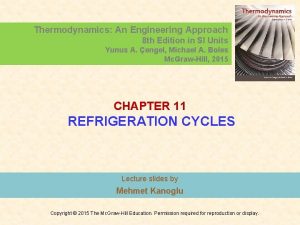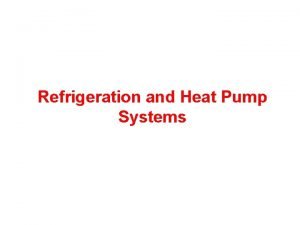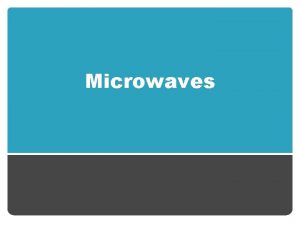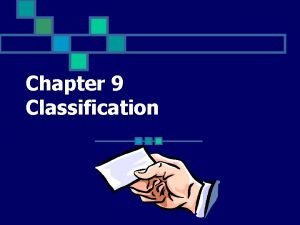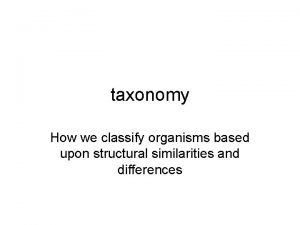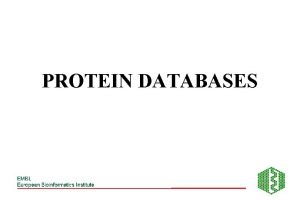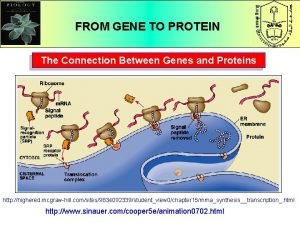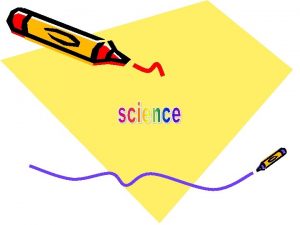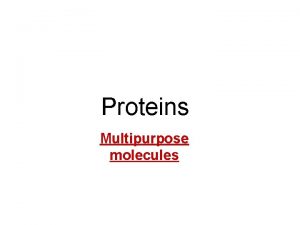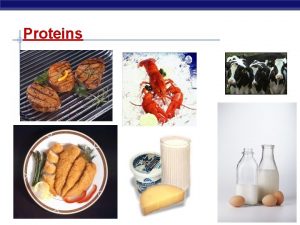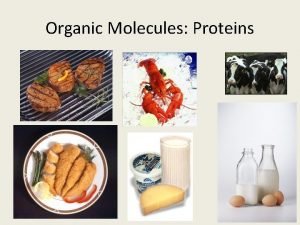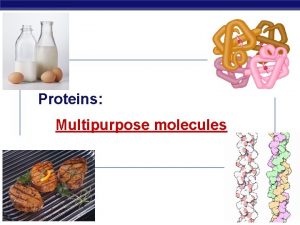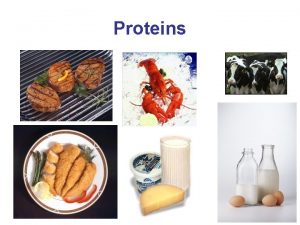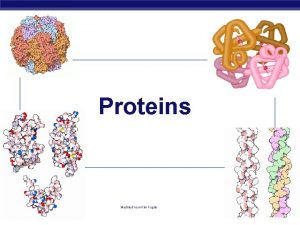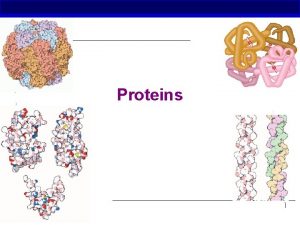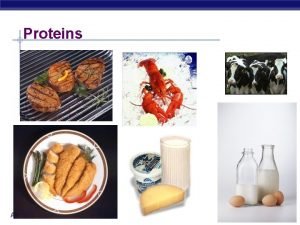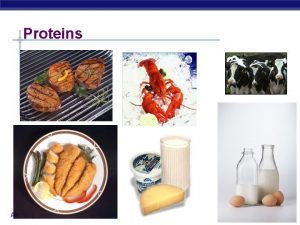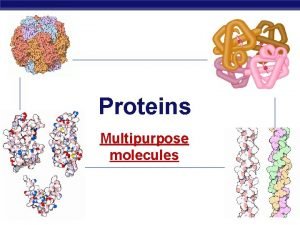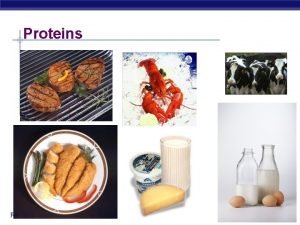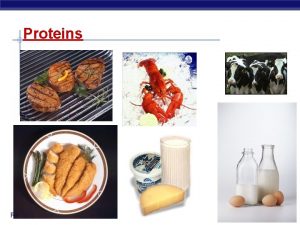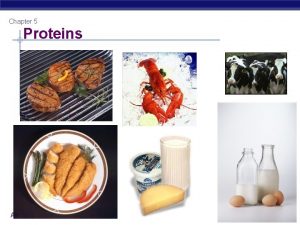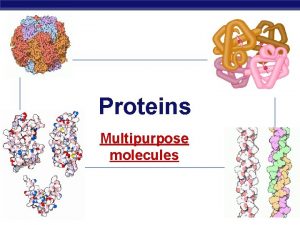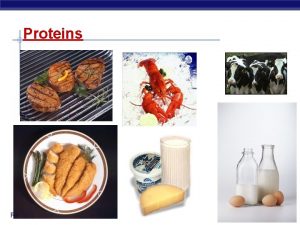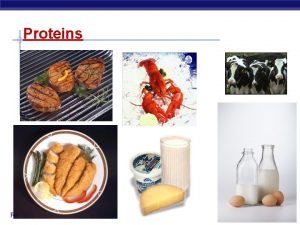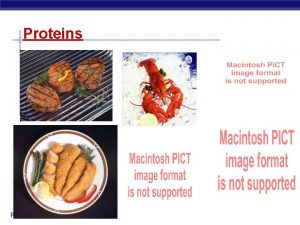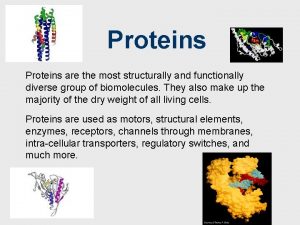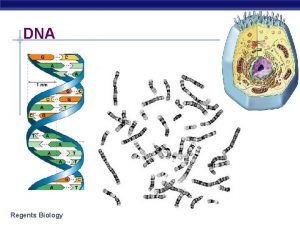Proteins Multipurpose molecules 2006 2007 Proteins Most structurally























- Slides: 23

Proteins Multipurpose molecules 2006 -2007

Proteins Most structurally & functionally diverse group of biomolecules Function: involved in almost everything Metabolism Support Transport Regulation Motion

Metabolism Enzymes Biological catalysts – speed up chemical reactions Digestive enzymes aid in hydrolysis o Lipase o Amylase o Lactase o Protease Molecular Biology o Polymerase o Ligase Industry o Dairy, baby food, rubber, beer, photography, contact lense cleaner

Support Structural proteins Keratin – hair and nails Collagen – supports ligaments, tendons, and skin Silk – cocoons and spider webs

Transport Channel and carrier proteins in the cell membrane Allows substances to enter and exit the cell Transport molecules in blood Hemoglobin – transports oxygen in the blood

Defense Antibodies Combat bacteria and viruses

Regulation Hormones Intercellular messengers that influence metabolism Insulin – regulates the amount of glucose in the blood and in cells Human growth hormone – its presence determines the height of an individual Receptor Proteins Built into the membranes of nerve cells Detect chemical signals (neurotransmitters) released by other nerve cells

Motion Muscle contraction Actin and myosin – make up muscle fibers Motor proteins within the cell Allow cell components to move from place to place Flagella- move the cell Cilia- move contents around the cell

Proteins Structure: monomer = amino acids 20 different amino acids 12 made by body 8 essential amino acids (must get from food) polymer = polypeptide protein can be one or more polypeptide chains folded & bonded together large & complex molecules complex 3 -D shape hemoglobin Rubisco growth hormones

Amino acids Structure: central carbon (α carbon) amino group carboxyl group (acid) R group (side chain) variable group confers unique chemical properties of the amino acid H O H | || —C— C—OH —N— | H R

Nonpolar amino acids nonpolar & hydrophobic

Polar amino acids polar or charged & hydrophilic

Sulfur containing amino acids Form disulfide bridges cross links betweens sulfurs in amino acids H-S – S-H You wondered why perms smelled like rotten eggs?

Building proteins Peptide bonds linking NH 2 of one amino acid to COOH of another C–N bond N terminus – C terminus dehydration synthesis peptide bond

Protein structure & function Function depends on structure 3 -D structure twisted, folded, coiled into unique shape pepsin hemoglobin collagen

Primary (1°) structure Order of amino acids in chain amino acid sequence determined by gene (DNA) slight change in amino acid sequence can affect protein’s structure & it’s function even just one amino acid change can make all the difference! lysozyme: enzyme in tears & mucus that kills bacteria

Sickle cell anemia

Secondary (2°) structure “Local folding” folding along short sections of polypeptide interaction between adjacent amino acids H bonds between backbones (O: H) -helix -pleated sheet Fibrous proteins – only have secondary structure Keratin Silk

Secondary (2°) structure

Tertiary (3°) structure “Whole molecule folding” created when the secondary structure fold and form bonds to stabilize the structure into a unique shape determined by interactions between R groups Hydrophobic interactions anchored by disulfide bridges Ionic Bonds between R groups Hydrogen bonds between backbones Van der Waals Force (velcro) Globular (spherical) proteins – have tertiary structure enzymes

Quaternary (4°) structure two or more tertiary folded peptide subunits bonded together to make a functional protein Hemoglobin – 4 polypeptides Collagen – 3 polypeptides collagen = skin & tendons hemoglobin

Protein structure (review) R groups hydrophobic interactions, disulfide bridges, ionic bonds 3° multiple polypeptides hydrophobic interactions 1° aa sequence peptide bonds determined by DNA 2° H bonds 4°

Denature a protein Unfolding a protein/changes the shape disrupt 3° structure temperature p. H unravels or denatures protein disrupts H bonds, ionic bonds & disulfide bridges destroys functionality
 Organic molecules vs inorganic molecules
Organic molecules vs inorganic molecules Multipurpose refrigeration systems with a single compressor
Multipurpose refrigeration systems with a single compressor Cop of refrigerator
Cop of refrigerator Introduction of secondary education commission 1952-53
Introduction of secondary education commission 1952-53 What molecules are microwaves most attracted to?
What molecules are microwaves most attracted to? In the name of allah the most beneficent the most merciful
In the name of allah the most beneficent the most merciful In the name of allah, the beneficent, the merciful
In the name of allah, the beneficent, the merciful In the name of allah the most gracious the most merciful
In the name of allah the most gracious the most merciful In the name of allah most gracious most merciful
In the name of allah most gracious most merciful In the name of allah most beneficent most merciful
In the name of allah most beneficent most merciful Name of organisms
Name of organisms The most gracious
The most gracious In the name of allah the most beneficent the most merciful
In the name of allah the most beneficent the most merciful Arrangement of organisms
Arrangement of organisms Most general to most specific classification
Most general to most specific classification Aqeedah meaning
Aqeedah meaning Beneficent pronunciation
Beneficent pronunciation In the name of god most gracious prayer
In the name of god most gracious prayer Most general to most specific classification
Most general to most specific classification In the name of god most gracious prayer
In the name of god most gracious prayer Database protein
Database protein What is the connection between genes and proteins
What is the connection between genes and proteins Structural protein
Structural protein Dairy produts
Dairy produts

